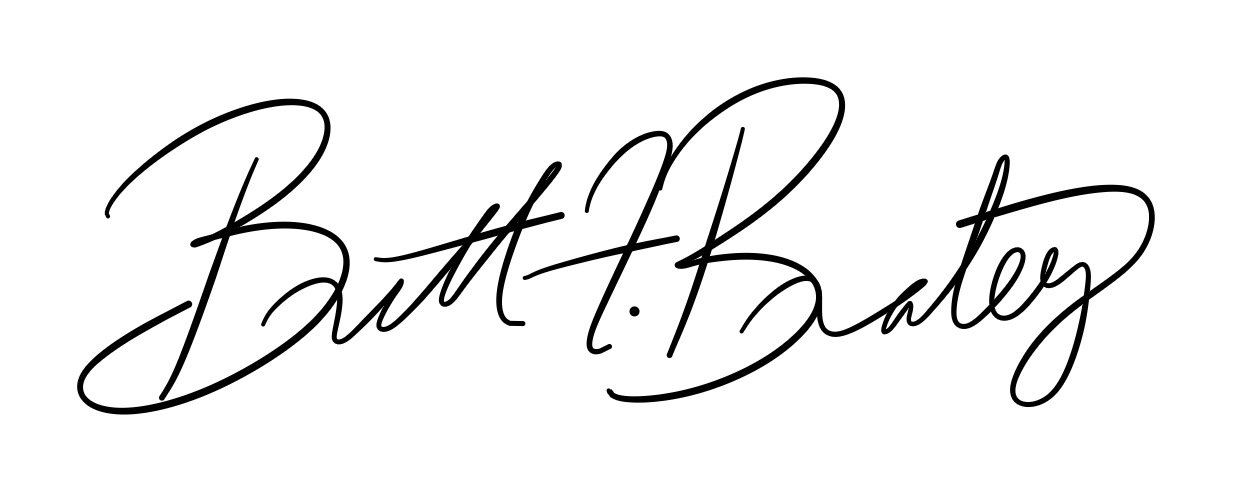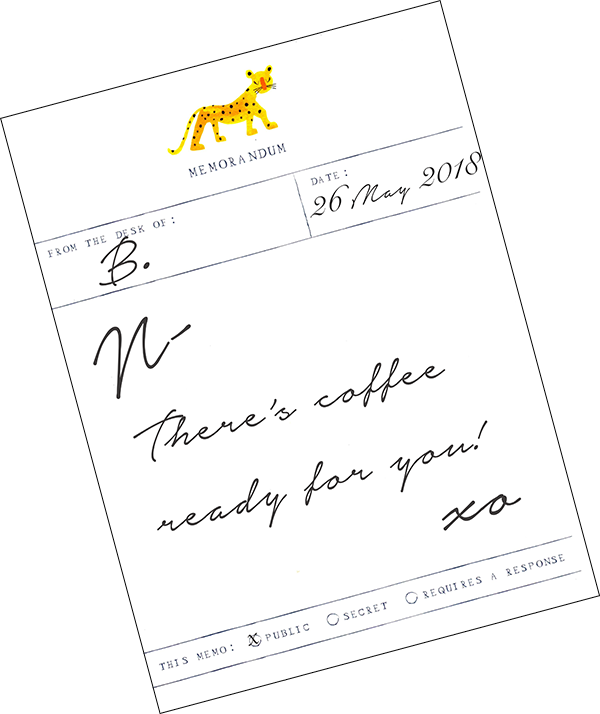How to Write a Note: With Mr. Boddington
I am a note writer by nature, it comes so easily to me. I have reams of bullet-pointed paper, scratched out and rewritten, all throughout my office. I write notes for myself. I write notes to Nolan. I've written notes throughout my childhood--too nervous for the confrontation, delaying the inevitable response for when they read my folded-up note at their leisure.
I have my current job due to a card I had written. In October of 2014, I had interviewed for a job as an executive assistant to the then-President of my company. I did not get the job. But, understanding that there was always opportunity in the future, I had written to the President and given my appreciation for her time all the same. December of that year, I moved to Texas for work with another company. It was not a good fit for me, but I did it all the same. The promise of an amorphous "career" loomed with the move and so I took the bait and drove to my new apartment in San Antonio.
In May, the person they hired instead of me was fired. And I got a call from the President. She asked if I would move back to California and work for her. She said she was holding my thank-you note in her hand. She hired me on the spot, offered me a generous salary to move back. Ten days later, I started.
The power of a notecard, a personal touch. It makes all the difference in the world. A card or letter is more than a pleasantry, a necessity, a routine; it's the artifact, the symbol, the proof that the recipient was on your mind for more than the transient interaction itself. I believe in the imbued quality of gentility that goes into a handwritten note. I believe in its ability to give the recipient a pause in their otherwise routine.
Because of this, I've put together a small guide for writing notes. It's not much, but it includes a few rules I follow. With the help of Mr. Boddington, I hope that it inspires others to continue to cherish the small instances of care that one forgets these days.
Thank You Notes: A Primer
If you remember, I received a couple writing sets from Mr. Boddington. Since then, I have been dying to find ways in which I could incorporate this stationery into my daily life. Thankfully, it was easy, considering that, between work and family/friends, I send a note to someone about once a week.
The cards in both the Tulum writing set and the Leopards desk set both are flat cards, meaning they do not need to be folded. In the above examples, I lined out the various parts of a correspondence card. I'm sure these seem pretty basic--and they are. But in the notes below, I lay out examples, tips from Mr. Boddington's book, and some of my own personal recommendations on writing an impactful note on the real estate of a notecard.
Parts of a Note.
A. Date
None of the the following notes should be considered dogma. In fact, most--if not all--can be construed as personal preference. The date is one such instance. For me, I prefer to write date in the European format. This is simply for aesthetic reasons, meaning that I like the numerical balance, enveloping the month in the middle. It always goes on the right.
B. Salutations/Greeting
I think that the greeting sets the tone of the entire note; but I also think that it's often overlooked. As Mr. Boddington put it, "Using the classic Dear Frida, is completely acceptable. Other favorites are Dearest, Good Morning (or Afternoon), My friend." I've been known to simply put the recipient's name for more formal notes, or a few pleasant adjectives ("To the wonderful, amazing Atlanta team") for informal and ingratiating notes.
C. Body
I've stared at this section for a while. How does one try to encapsulate such a personal, malleable, and vague portion of the note into a bullet point? The best advice I can give is to keep it to the point.
In the example, please find an example that Deborah Cavendish, Duchess of Devonshire ("Debo") wrote to her sister, Lady Diana Moseley ("Honks"). What I liked about this example is its brevity, its directness in its questioning, and how it ends with a story. This was all done in 8 lines of copy. For most notes, I don't think you need to worry about expending any real estate on, "What's up?" or, "How are you?" In fact, I think it's counterproductive, considering it's not an immediate conversation and when the recipient replies, he or she won't answer, "While reading your note I was cutting flowers" or whatever else was "up".
Further, whether the note is a thank-you, a congratulations, a sympathy card - all should follow the similar rule of keeping it to the point. Here are a few rules I follow:
For thank-you: Give your appreciation in the very first line. Then, somewhere in the copy, say one reason why you love it, then the enthusiastic "We can't wait to use X". (Eg, Thank you so much for the new china set. We absolutely love the pattern. I can't wait to use it this summer for our picnics in the garden).
For congratulations: I think the hardest thing about this one is making sure you're not overly sentimental, but respectfully prideful of one's accomplishments. For this, again, keep it direct, then leave with a compliment (You always were great at equestrian). I think we tend to want to flourish the language to really let someone know our enthusiasm at their success, that we overdo it on occasion.
Sympathy: Purposefully vague but genuinely sorry is the best way I can describe these types of cards. In my current role, I've had to write eight (too many!) condolences cards for my coworkers losing their parents. Not wanting to take away from their grieving through my own letterwriting, I try to keep it non-denominational, understated, and meaningful. Using cliches here may not be a bad thing - you are truly sorry for their loss! But, noncommittal terms such as "He's in a better place" doesn't always have the same gratification, in my opinion.
For any and all of these types of correspondence, I think we need to do more of them. In the current book I am reading, The Mitfords: Letters Between Six Sisters by Charlotte Moseley, the six Mitford sisters wrote to one another for over 70 years, compiling hundreds of thousands of letters detailing every part of their lives. I was inspired by their letters' oftentimes banality, but also their wit, sympathy, excitement, and hope that jumped off the pages. Why can't we do this, too? What has stopped us, other than the advancing immediacy of technology? Increase in instant gratification (texts, emails, Facebook) should not preclude the human touch we all of us are losing. I implore more letter writing out of each of you, for small victories and large deaths and promotions and birthdays and thank-you-for-dinners. All of it.
D. Closing and Signature
How funny that the formality and occasion of a note dictate how it should close. Due to the alliteration of my name, I'm fond of using "Best" for most scenarios. But a quick "XOXO" will do for my loved ones. It's hard to be creative when there are the standard-bearers of typical closing words ("Sincerely", "Yours", "Always", "Regards"), so perhaps try to be a bit creative here. But not too much so that it comes off as sophomoric. One co-worker of uses the closing "Forever attentively" and I roll my eyes at this self-congratulating.
The signature need not be anything but your first name in whatever style you sign it. I like to do it a tad differently in script than my note (larger, or more flourished). As Mr. Boddington points out, for more formal or new acquaintances, use first and last.
Celebrating the Ordinary
For me, as I've already said, writing notes is completely natural to me. And while I do not receive the amount of notes I send, I do not expect to.
Mr. Boddington's memorandum notepad is the absolute perfect medium for these everyday notes for me, especially to Nolan. Usually tucked under his keys before work, you'll find a note of some sort for him to read. Working from home affords me a certain knowledge of the house, our chores, etc that I like to keep him informed, too. These I keep simple, a quick jot with an XO scribbled for good measure.
I think what notes like this do better than texting is that one can now look back to it. We receive so many messages on our phones a day, it's hard to keep track. This way, it's a physical reminder of something you may not want to forget. Alternatively, a small love note (like the one I had waiting for Nolan after Iceland) still hangs on our refrigerator, reminding us of relaxed days when things may be a little stressful.
Closing Remarks
Nothing I've said here should be mind-blowing. It really shouldn't be. We naturally know how to form a letter. I remember most of these steps in the 6th grade for a composition class. But, it's the recalling each components' individual meaning that matters. I'm a huge advocate for taking five minutes and a 49 cent stamp to make someone else's day a little brighter. I'm so fortunate to have found Mr. Boddington to share in this missive with me.


